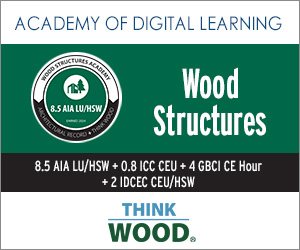Multi-Family, Mid-Rise Wood Buildings
 1 AIA LU/HSW; 1 GBCI CE Hour; 0.1 ICC CEU; 0.1 IACET CEU*; 1 AIBD P-CE; AAA 1 Structured Learning Hour; This course can be self-reported to the AANB, as per their CE Guidelines; AAPEI 1 Structured Learning Hour; This course can be self-reported to the AIBC, as per their CE Guidelines.; MAA 1 Structured Learning Hour; This course can be self-reported to the NLAA.; This course can be self-reported to the NSAA; NWTAA 1 Structured Learning Hour; OAA 1 Learning Hour; SAA 1 Hour of Core Learning
1 AIA LU/HSW; 1 GBCI CE Hour; 0.1 ICC CEU; 0.1 IACET CEU*; 1 AIBD P-CE; AAA 1 Structured Learning Hour; This course can be self-reported to the AANB, as per their CE Guidelines; AAPEI 1 Structured Learning Hour; This course can be self-reported to the AIBC, as per their CE Guidelines.; MAA 1 Structured Learning Hour; This course can be self-reported to the NLAA.; This course can be self-reported to the NSAA; NWTAA 1 Structured Learning Hour; OAA 1 Learning Hour; SAA 1 Hour of Core Learning
Learning Objectives:
- Identify the sustainability and economic benefits of using wood construction for mid-rise multi-family or mixed-use buildings.
- Summarize building code requirements and provisions for mid-rise multi-family wood-frame structures.
- Discuss wood framing solutions that address issues such as shrinkage, fire protection and seismic requirements while minimizing the carbon footprint of the building.
- Explore innovations in wood framing design techniques and wood product technologies that enhance energy efficiency.
This course is part of the Wood Structures Academy
Designing With Innovative Wood Products And Building Systems
Beyond conventional framing, there are numerous innovative technologies and building systems that are increasing the opportunities for multifamily wood buildings.
Prefabricated Systems and Modular Construction
The use of prefabricated or factory manufactured wall and roof panels can provide better quality wall construction since the panels are constructed off-site in moisture-controlled environments. Wall panelizing is particularly useful for job sites without adequate space to construct the walls, and panelization can speed erection time considerably. Wall panels can also optimize stud design and increase soundproofing and energy efficiency. Panel lengths can range from 4 to 30 feet long, and are lifted into place by a crane.
Full modular construction is a growing element of multifamily construction because it offers a fast, cost-effective construction option. Building modules are fabricated off-site, complete with finished exteriors and interiors, including mechanical systems. The modules are simply lifted into place and connected at the job site. In many cases, these modules can arrive up to 95 percent complete. For example, 38 Harriet, a four-story apartment project in San Francisco, was completed in just six months, from groundbreaking to completion. And Mountaineer Hall, a student housing structure at Appalachian State University in North Carolina, met the university’s deadline to add 460 beds for students in just nine months.
Mass Timber
While traditional light-frame wood construction is a proven building solution for mid-rise structures up to six stories tall, mass timber products, including cross-laminated timber (CLT), are creating new design possibilities. CLT is a multilayer, solid-sawn lumber or structural composite lumber (SCL) wood panel in which each layer is oriented crosswise to its adjacent layer for increased dimensional stability and structural performance.
Widely used in Europe and increasingly available in North America, mass timber is an innovative construction option for mid-rise and, in the 2021 IBC, tall multifamily buildings. Several tall wood buildings, including the 18-story UBC Brock Commons student housing project in Vancouver, British Columbia, have already demonstrated mass timber’s suitability for this building type.
The 2015 IBC was first to incorporate CLT as a structural building product when it was recognized for use in Type IV (heavy timber, HT) construction. In response to the increasing use of CLT and other mass timber building components in Types III, IV, and V construction, the 2018 IBC added more detail to clarify the requirements of heavy timber construction. Comprehensive new mass timber construction types were added to the 2021 IBC through the work of an ad hoc committee of the International Code Council that was ratified by the membership in 2018. These new construction types permit mass timber buildings of considerably more allowable area and with heights up to 18 stories to be built under the code.
Among CLT’s attractive structural characteristics are high dimensional stability, high axial-load capacity, high shear strength, rigidity around openings, and negligible settlement effects. CLT assemblies also offer inherent fire resistance due to thick cross sections that, when exposed to fire, char at a slow and predictable rate. Other benefits include speed of construction, thermal performance, and the environmental advantages offered by all wood products— including a low carbon footprint.
Conclusion
Wood use for multifamily construction is growing, driven by wood’s acceptance in building codes and the value, safety, and durability that wood building products and systems provide. Design professionals recognize that wood can provide value and versatility in designing projects ranging from affordable housing to luxury condominiums. Building with wood also helps achieve efficiencies that allow developers to provide amenities more commonly found in higher-end projects. Wood is recognized as a renewable and energy-efficient material helping with green building certification and sustainability overall. There are numerous design techniques that can be used to accommodate some of the special considerations required with wood construction for mid-rise, multifamily wood-frame construction, including shrinkage, fire protections, and seismic requirements. Wood can also contribute to the energy efficiency goals of the project. Since building codes recognize the inherent safety and performance capabilities of wood in multifamily buildings, innovative technologies and products can be expected to propel designers to even greater heights.
Additional Resources
American Wood Council
The American Wood Council is committed to ensuring a durable, safe, and sustainably built environment. To achieve these objectives, AWC contributes to the development of sound public policies, codes, and regulations which allow for the appropriate and responsible manufacture and use of wood products. The AWC develops consensus standards, comprehensive technical guidelines, and tools for wood design and construction, as well as providing education regarding their application. www.awc.org
Wood Products Council, WoodWorks
WoodWorks provides education and free technical support related to the design, engineering, and construction of commercial and multifamily wood buildings in the U.S. A nonprofit staffed with architects, structural engineers, and construction experts, we have the expertise to assist with all aspects of wood building design. For assistance with a project, email help@woodworks.org. www.woodworks.org
Design Guidance And Resources
There are many resources available to architects and engineers designing light-frame and mass timber projects.
- For general information, the Think Wood website (www.thinkwood.com) offers an expanding library of materials on mass timber products, research, building examples, and developments related to tall wood buildings.
- The National Design Specification (NDS) for Wood Construction (www.awc.org) is the IBC-referenced design standard for lumber, glulam, SCL, and CLT, including fire design, fasteners, and connections, etc. A mass timber building in the United States cannot be designed without the NDS.
- The U.S. CLT Handbook (www.thinkwood.com) includes detailed technical information on the use of CLT. It should be used in conjunction with information provided by manufacturers since most CLT currently available in North America is proprietary (i.e., lay-ups aren’t standard across suppliers).
- American Wood Council’s 2018 Code Conforming Wood Design
- WoodWorks’ Five-Story, Wood-Frame Structure over Podium Slab
End Notes
1 National Multifamily Housing Council
2 Project Efficiencies, ThinkWood
3 Wood Brings the Savings Home, WoodWorks
4 Student Housing gets Extra College Credit from Wood, WoodWorks
5 Life Cycle Environmental Performance of Renewable Building Materials in the Context of Building Construction, Consortium for Research on Renewable Industrial Materials, Phase I 2005, Phase II 2010; A Synthesis of Research on Wood Products and Greenhouse Gas Impacts, Sarthre, R. and J. O’Connor, 2010, FPInnovations; Werner, F. and Richter, K. 2007, Wooden building products in comparative LCA: A literature review, International Journal of Life Cycle Assessment
6See endnote 5.
9 WoodWorks, Maximizing View and Value with Wood
10 2018 International Building Code, Section 506.3
11 Tall with Timber: Seattle Mass Timber Tower Case Study. (2018). DLR Group
12 https://constructionfiresafety.org/
13 The ShakeOut Scenario—Woodframe Buildings, URS Corporation, prepared for the U.S. Geological Survey and California Geological Survey, 2008
14 youtube.com/watch?v=c25HuZeQsyo&context=C3f612acADOEgsToPDskLH3EQs-aodM9-NsZgF2lGi
15 Van de Lindt, John W.; Gupta, Rakesh; Pei, Shiling; Tachibana, Kazuki; Araki, Yasuhiro; Rammer, Douglas; Isoda, Hiroshi. 2012. Damage assessment of a full-scale six-story wood-frame building following triaxial shake table tests, Journal of Performance of Constructed Facilities 26(1): 17-23,










